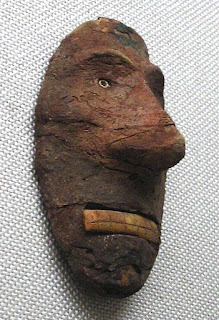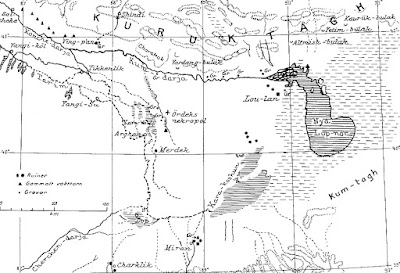Discover (Slavic World); Wiki; Pat Macpherson, Dhr. Seven, CC Liu (eds.), Wisdom Quarterly
 |
| Mummies found in China are "white" or the more scientific sounding "Caucasoid." |
 |
| Wearing Celtic pattern wool |
The mummies, particularly the early ones, are frequently associated with the presence of the Indo-European Tocharian languages in the Tarim Basin...
The earliest Tarim mummies, found at Qäwrighul and dated to 1800 BCE, are of a Caucasian physical type, whose closest affiliation is to the Bronze Age populations of southern Siberia, Kazakhstan, Central Asia, and the Lower Volga (Mallory & Mair, 2000, p. 237).
The cemetery at Yanbulaq contained 29 mummies which date from 1100-500 BCE, 21 of which are Mongoloid -- the earliest Mongoloid mummies found in the Tarim Basin -- and eight of which are of the same Caucasian physical type found at Qäwrighul (ibid). Notable mummies are the:
- tall, red-haired "Chärchän Man" or "Ur-David" (1000 BCE);
- his son (1000 BCE), a small 1-year-old baby with brown hair protruding from under a red and blue felt cap, with two stones positioned over its eyes;
- the "Hami Mummy" (circa 1400-800 BCE), a "red-headed beauty" found in Qizilchoqa; and
- the "Witches of Subeshi"* (4th or 3rd century BCE), who wore 2-foot-long (0.61 m) black felt conical hats with a flat brim. Also found at Subeshi was a man with traces of a surgical operation on his abdomen; the incision is sewn up with sutures made of horsehair ("The Mummies of Xinjiang," Discover, April 1, 1994).
Genetic testing of the discoveries

(SW) After years of controversy and political intrigue, archaeologists using genetic testing have proven that Caucasians roamed China's Tarim Basin 1,000 years before East Asian people are thought to have arrived.

(SW) After years of controversy and political intrigue, archaeologists using genetic testing have proven that Caucasians roamed China's Tarim Basin 1,000 years before East Asian people are thought to have arrived.
Asiatic-Caucasoids, tall people with red and blond hair and light eyes, had long been the subject of ancient Asian legends.
Then, in the early 20th century, archeologists digging in the Tarim Basin in western China, unearthed mummies resembling these legendary space "gods" (devas and/or deva-human hybrids).
It is unfortunate that the issue has been so politicized because it has created a lot of difficulties. It would be better for us all to approach this from a dispassionate, scientific, and historical perspective.
The discoveries in the 1980s of the undisturbed 4,000-year-old "Beauty of Loulan" and the younger 3,000-year-old body of the "Cherchen Man" are legendary in world archaeological circles for the fine state of their preservation and for the wealth of knowledge they bring to modern research.
In historic and scientific circles the discoveries along the ancient Silk Road were on a par with finding Egyptian mummies.
Mair, who played a pivotal role in bringing these discoveries to Western scholars in the 1990s, has worked tirelessly to get Chinese approval to take samples out of China for definitive genetic testing.
One expedition in recent years succeeded in collecting 52 samples with the aide of Chinese researchers, but later Mair's hosts had a change of heart and only let five of them out of the country.
"I spent six months in Sweden last year doing nothing but genetic research," Mair said from his home in the United States, where he teaches at the University of Pennsylvania.
"My research has shown that in the second millennium BC, the oldest mummies, like the Loulan Beauty, were the earliest settlers in the Tarim Basin.
"From the evidence available, we have found that during the first 1,000 years after the Loulan Beauty, the only settlers in the Tarim Basin were Caucasoid."
East Asian peoples only began showing up in the eastern portions of the Tarim Basin about 3,000 years ago, Mair said, while the Uighur peoples arrived after the collapse of the Orkon Uighur Kingdom, largely based in modern-day Mongolia, around the year 842.
"Modern DNA and ancient DNA show that Uighurs, Kazaks, Krygyzs, the peoples of Central Asia [where the Buddha was from, Kapilavastu in "Shakya Land" or Scythia] are all mixed Caucasian and East Asian. The modern and ancient DNA tell the same story," he said.
China has only allowed the genetic studies in the last few years, with a 2004 study carried out by Jilin University also finding that the mummies' DNA had Europoid genes, further proving that the earliest settlers of Western China were not East Asians.
In the preface to the 2002 book, Ancient Corpses of Xinjiang: The Peoples of Ancient Xinjiang and Their Culture, written by Chinese archeologist Wang Huabing, the Chinese historian and Sanskrit specialist Ji Xianlin soundly denounced the use of the mummies by Uighur separatists as proof that Xinjiang should not belong to China.
"What has stirred up the most excitement in academic circles, both in the East and the West, is the fact that the ancient corpses of 'white (Caucasoid/Europid) people' have been excavated," Jin wrote.
"However, within China a small group of ethnic separatists have taken advantage of this opportunity to stir up trouble and are acting like buffoons, (styling) themselves the descendants of these ancient 'white people' with the aim of dividing the motherland."
Further on, in an apparent swipe at the government's lack of eagerness to acknowledge the science and publicize it to the world, Ji wrote that "a scientist may not distort facts for political reasons, religious reasons, or any other reason."
Meanwhile, Yingpan Man, a nearly perfectly preserved 2,000-year-old Caucasoid mummy, was only recently allowed to leave China for the first time, and it is being displayed at the Tokyo Edo Museum.
Yingpan Man not only had a gold foil death mask -- a Greek [and possibly Scythian] tradition -- covering his blonde bearded face, but also wore elaborate golden embroidered red and maroon garments with seemingly Western European designs.
His nearly 2.00 meter (six-foot, six-inch) long body is the tallest of all the mummies found so far and the clothes and artifacts discovered in the surrounding tombs suggest the highest level of Caucasoid civilization in the ancient Tarim Basin region.
Then, in the early 20th century, archeologists digging in the Tarim Basin in western China, unearthed mummies resembling these legendary space "gods" (devas and/or deva-human hybrids).
 |
| Map of Eurasia, Central Asia, Tarim Basin, China, and routes of the Silk Road (forbes.com) |
.
The research, which the Chinese government has appeared to have delayed making public out of concerns of fueling Uighur Muslim separatism in its western-most Xinjiang region, is based on a cache of ancient dried-out corpses that have been found around the Tarim Basin in recent decades.It is unfortunate that the issue has been so politicized because it has created a lot of difficulties. It would be better for us all to approach this from a dispassionate, scientific, and historical perspective.
The discoveries in the 1980s of the undisturbed 4,000-year-old "Beauty of Loulan" and the younger 3,000-year-old body of the "Cherchen Man" are legendary in world archaeological circles for the fine state of their preservation and for the wealth of knowledge they bring to modern research.
In historic and scientific circles the discoveries along the ancient Silk Road were on a par with finding Egyptian mummies.
- [And they may have a common origin from the advanced space arrivals who took up residence in Egypt, with its oblong-headed gods and goddesses and hybrid giants called pharaohs.]
Mair, who played a pivotal role in bringing these discoveries to Western scholars in the 1990s, has worked tirelessly to get Chinese approval to take samples out of China for definitive genetic testing.
One expedition in recent years succeeded in collecting 52 samples with the aide of Chinese researchers, but later Mair's hosts had a change of heart and only let five of them out of the country.
"I spent six months in Sweden last year doing nothing but genetic research," Mair said from his home in the United States, where he teaches at the University of Pennsylvania.
"My research has shown that in the second millennium BC, the oldest mummies, like the Loulan Beauty, were the earliest settlers in the Tarim Basin.
"From the evidence available, we have found that during the first 1,000 years after the Loulan Beauty, the only settlers in the Tarim Basin were Caucasoid."
 |
| Europoid mask, Lop Nur, China, 2000-1000 BCE |
"Modern DNA and ancient DNA show that Uighurs, Kazaks, Krygyzs, the peoples of Central Asia [where the Buddha was from, Kapilavastu in "Shakya Land" or Scythia] are all mixed Caucasian and East Asian. The modern and ancient DNA tell the same story," he said.
China has only allowed the genetic studies in the last few years, with a 2004 study carried out by Jilin University also finding that the mummies' DNA had Europoid genes, further proving that the earliest settlers of Western China were not East Asians.
 |
| Map of Lop Nur [Lop Lake] by Folke Bergman, 1935. Kara-Koshun, where the terminal lake was found in 1867, is located to the south-west of Lop Nor, and the lake had shifted back to Lop Nor by the time this map was drawn. Taitema Lake was a smaller transit lake and located to the west of Kara-Koshun. |
In the preface to the 2002 book, Ancient Corpses of Xinjiang: The Peoples of Ancient Xinjiang and Their Culture, written by Chinese archeologist Wang Huabing, the Chinese historian and Sanskrit specialist Ji Xianlin soundly denounced the use of the mummies by Uighur separatists as proof that Xinjiang should not belong to China.
"What has stirred up the most excitement in academic circles, both in the East and the West, is the fact that the ancient corpses of 'white (Caucasoid/Europid) people' have been excavated," Jin wrote.
"However, within China a small group of ethnic separatists have taken advantage of this opportunity to stir up trouble and are acting like buffoons, (styling) themselves the descendants of these ancient 'white people' with the aim of dividing the motherland."
 |
| The Ancient Corpses of Xinjian (Wang, et. al) |
Meanwhile, Yingpan Man, a nearly perfectly preserved 2,000-year-old Caucasoid mummy, was only recently allowed to leave China for the first time, and it is being displayed at the Tokyo Edo Museum.
Yingpan Man not only had a gold foil death mask -- a Greek [and possibly Scythian] tradition -- covering his blonde bearded face, but also wore elaborate golden embroidered red and maroon garments with seemingly Western European designs.
His nearly 2.00 meter (six-foot, six-inch) long body is the tallest of all the mummies found so far and the clothes and artifacts discovered in the surrounding tombs suggest the highest level of Caucasoid civilization in the ancient Tarim Basin region.



































































































































































































































No comments:
Post a Comment